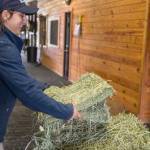Horse Owners’ Knowledge and Attitudes About Hay

When pastures go dormant, owners typically purchase hay to meet the nutritional needs of their horses. With an eye on understanding how owners buy hay, what they are looking for, and how they are feeding it, researchers conducted a survey of over 400 Pennsylvania-based horse owners.* A synopsis of key attitudes regarding purchasing and feeding decisions follows.
- Most owners (87%) purchased their hay directly from local farmers. These owners (60%) procured their hay from a regular supplier, preferring not to shop around unless their regular supplier did not have what they needed. Only 20% of survey respondents produced their own hay, but may have also purchased hay during the year. Others both grew hay and purchased hay throughout the year.
- The most popular bale size was the traditional two-string, small square bales weighing 40-50 lb (93% of survey respondents). Reasons for choosing this size were lack of adequate storage for larger bales and an inability to easily transport or handle them. Owners also shied away from large bales because they were concerned about botulism and respiratory disease secondary to inhaling dust during consumption.
- Grass and grass/legume mix hays were the most popular, including orchardgrass and timothy.
- Fifty-three percent of respondents preferred second or later cuttings, while 43% preferred first cutting. The choice was based on the owner’s impression of which was higher quality. Hay cutting information can provide a general guide to the hay’s digestibility and nutritional value. First-cutting grass hay generally has a higher stem-to-leaf ratio, lower crude protein, and higher fiber content compared to the second cutting,” said Catherine Whitehouse, M.S., a Kentucky Equine Research nutritionist. “However, the main factor governing hay quality is the stage of plant maturity at harvest, not the specific cutting. Cutting alone does not tell us much about the hay’s nutritional value.”
- Owners found absence of mold and weeds as well as the smell of the hay either very important or important when selecting hay. “It is essential to select and feed hay free from mold, dust, weeds, and toxic plants. Well-preserved hay should have a pleasant smell. Certain odors, such as a musty or tobacco-like smell, can indicate when to pass on feeding the hay,” Whitehouse said.
- Available hay analysis was not considered an important factor when selecting hay. Most respondents (62%) reported they never had their hay analyzed, and only a handful were interested in hay analysis. When they were interested, reasons included being able to balance their horse’s diet or checking sugar, starch, or mineral levels for horses with underlying health concerns such as equine metabolic syndrome, hyperkalemic periodic paralysis, or polysaccharide storage myopathy. Less than one-third of owners had confidence in interpreting or understanding hay analysis results, reasons owners may not have hay analyzed or consider hay analysis important. According to Whitehouse, “Hay testing is always a good management tool, especially when caring for a horse with special nutritional needs. When hay analysis is available prior to purchase, horse owners can work with an equine nutritionist, feed specialist, or university extension specialist to understand the results and receive assistance in selecting the right type of hay.” If horse owners decide to have the hay analyzed, it is important to consider which analytical package is best for their needs and goals. “Consulting with the laboratory or equine nutrition specialist can help owners receive appropriate nutrient information,” she said.
- Some owners (18%) stated they preferred purchasing hay with the highest quality nutritional value, such as energy or protein, regardless of their horse’s activity level. Over half (58%) stated they try to select hay that will work for all their horses’ current weights and activity levels. Others indicated they select multiple batches of hay for horses with different weights and activity levels. “Hay quality describes the amount of digestible energy available. A high-quality hay supplies more calories per pound or kilogram, plus higher crude protein and lower fiber, than a moderate- or low-quality hay,” Whitehouse said. “It is important to select hay that matches the horse’s nutritional needs so that forage intake can be maximized rather than restricted in diet. Horses that have lower energy needs such as easy keepers or mature horses not in work should be fed moderate-quality grass hay that can be fed in larger amounts without oversupplying calories.”
Icing on the Hay
Many horses meet, or even exceed, their energy needs from hay alone. But even the best hay does not provide complete nutrition and requires supplementation.
“Some horses may need a vitamin and mineral supplement, whereas other horses benefit from a ration balancer or fortified concentrate when additional calories are needed,” advised Whitehouse.
*Kenny, L.B., and D.N. Smarsh. 2024. Characterizing hay buying and feeding practices and attitudes among Pennsylvania horse owners. Journal of Equine Veterinary Science: doi: 10.1016/j.jevs.2024.105147.








